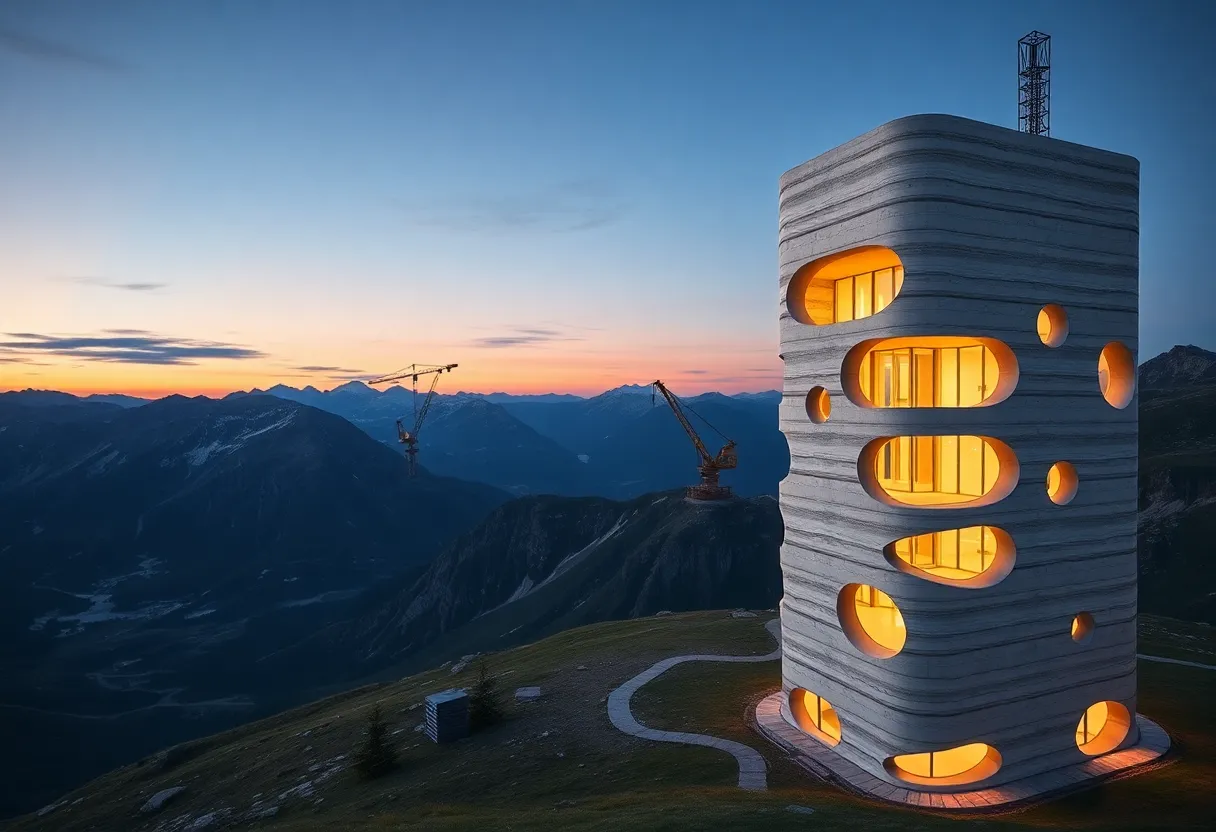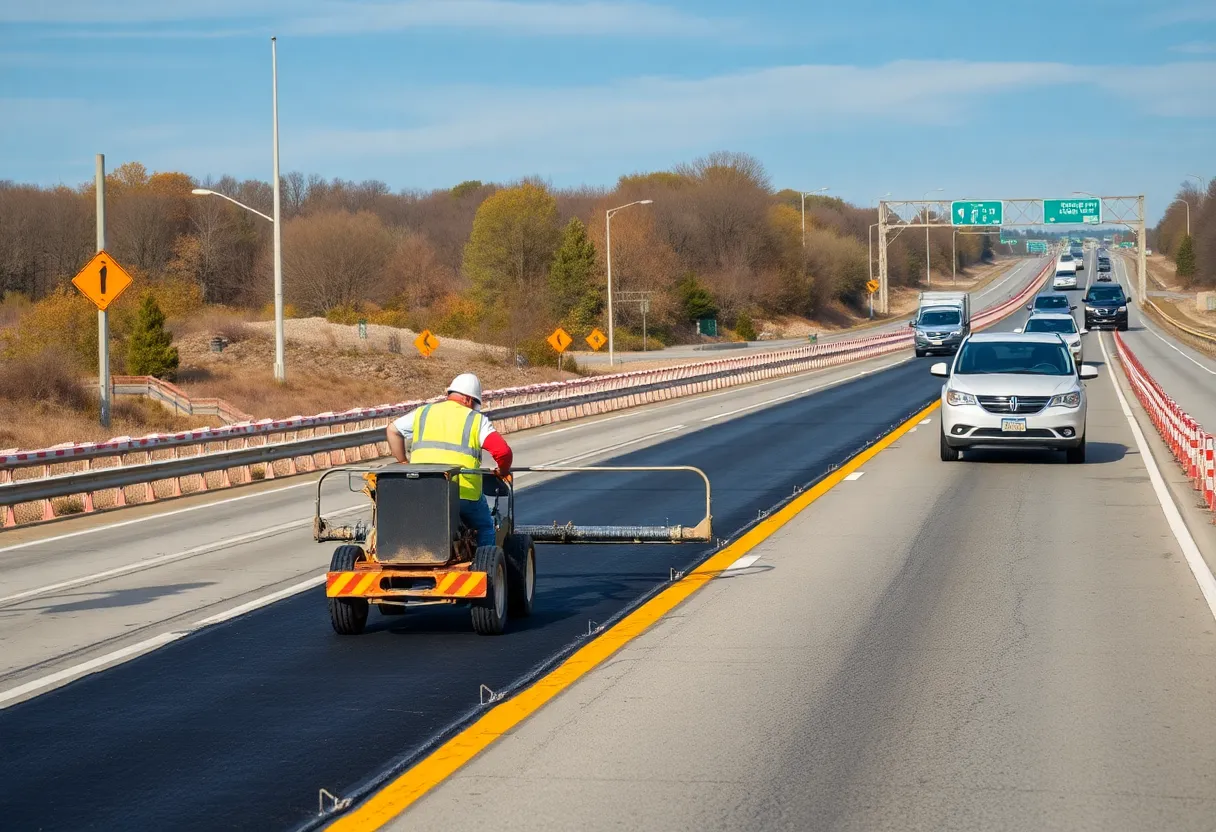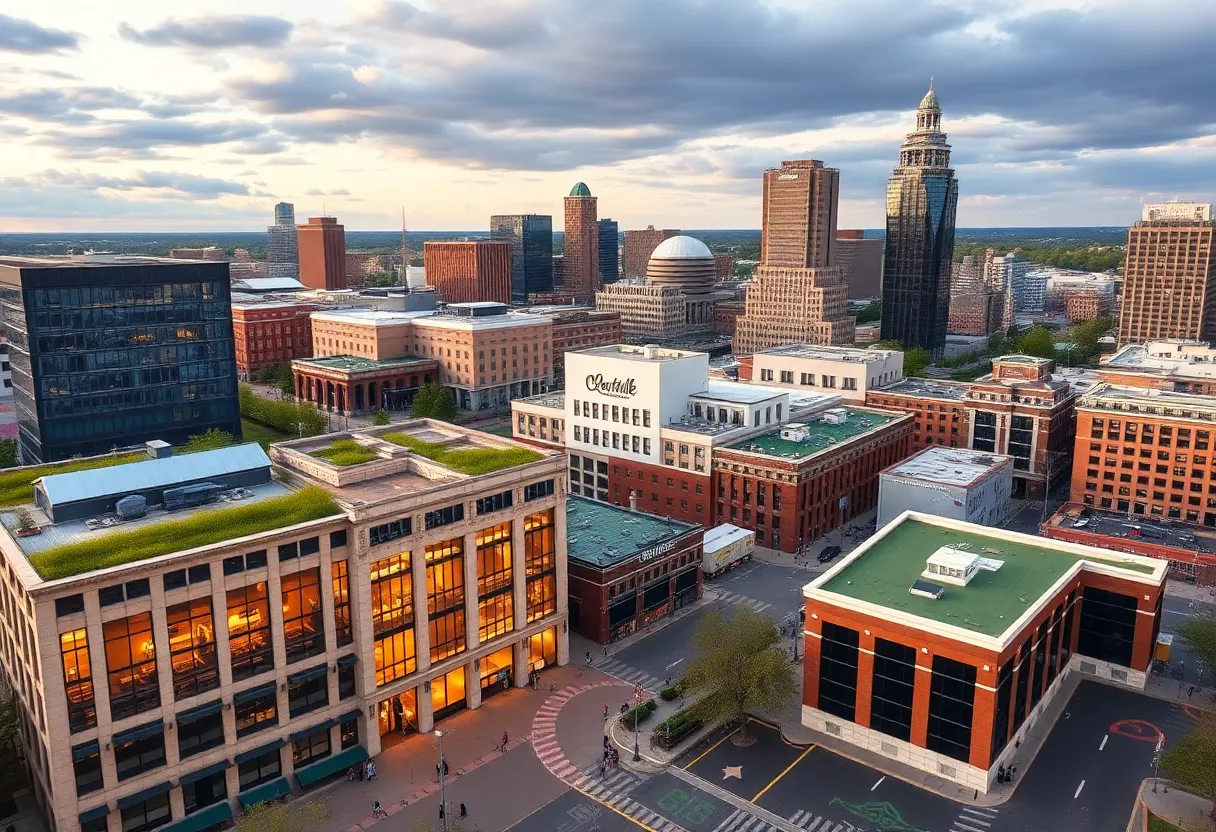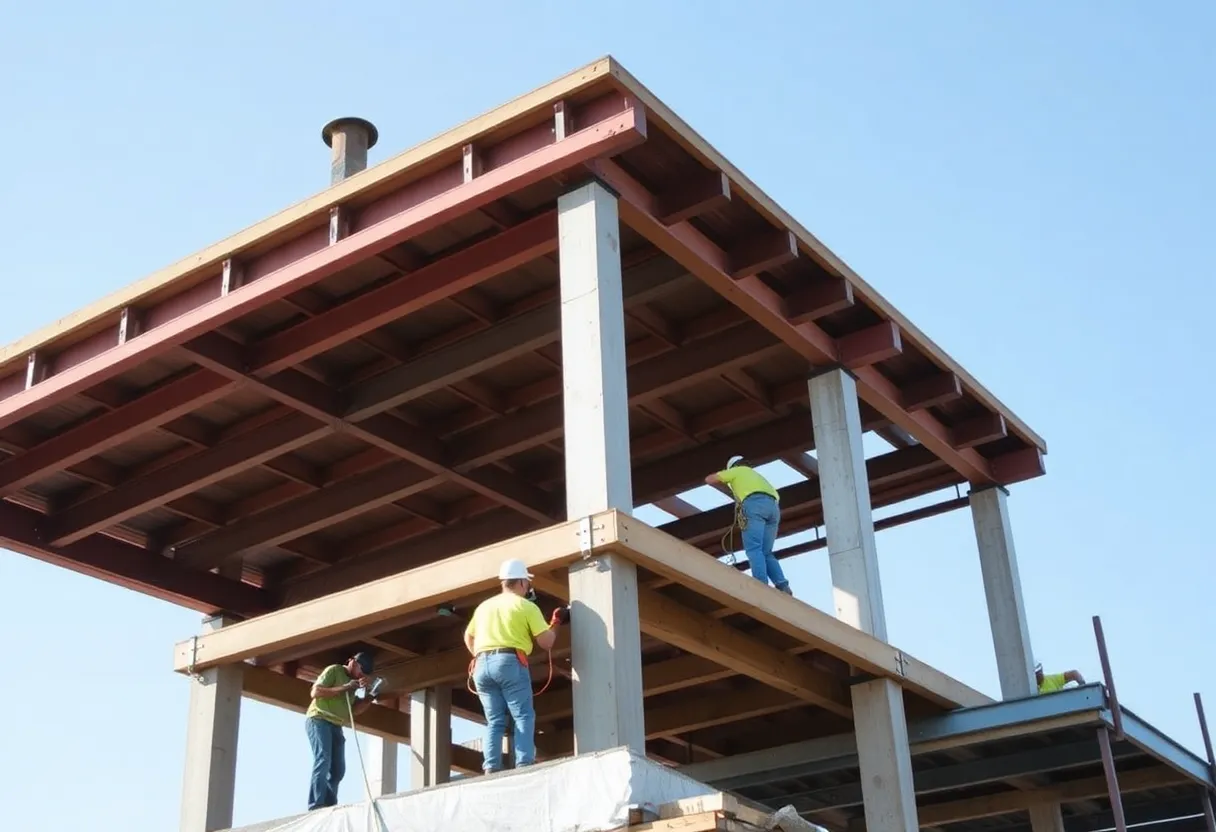Mulegns, Julier Pass, Swiss Alps, August 13, 2025
News Summary
Tor Alva, also called the White Tower, is a 30‑metre, four‑storey modular tower built with robotic 3D printing of hollow concrete columns. Designed and fabricated using coordinated robot arms, a fast‑hardening soft concrete mix and embedded reinforcement, the structure uses dry connections and removable fastenings so it can be disassembled and re‑erected elsewhere. The tower houses a vaulted top‑floor concert space and twisting interior rooms, and was developed with industry partners to explore circular construction, lower lifetime waste and strategies to extend service life despite material trade‑offs in embodied carbon.
ETH Zurich unveils Tor Alva: a 30 m, four‑storey 3D‑printed concrete tower built for reuse
Tor Alva, also called the White Tower, opened in May 2025 on the Julier Pass above Mulegns in the Swiss Alps. The 30‑metre structure is a four‑storey, modular building described as the world’s tallest 3D‑printed concrete tower. It was unveiled on 20 May 2025 and from 23 May 2025 it is open for guided tours. The tower is planned to host staged performances beginning in July 2025 and is expected to remain on site for about five years before it can be taken apart and reassembled elsewhere.
Top-line facts
The project was commissioned by a cultural foundation and led by a team at ETH Zurich with design by two architects. The work combined digital design, robotic fabrication and new concrete mixes developed by several ETH research groups and industry partners including Sika, BASF and Knauf. Two ETH spin‑offs also took part in the effort. Funding and local support came from a university foundation, the nearby Surses community and private donors.
How it was made — the technical core
The tower is built from a set of hollow, branching columns that twist and wrap around interior rooms. The printed parts were produced with a layered, soft concrete mix that needed no traditional formwork. Printing of the first columns began on 1 February 2024. The first eight lower columns were printed by a robot at ETH’s facilities in Zurich and were later moved and assembled on site in May 2024. The project reached completion in May 2025.
The fabrication used coordinated robotic work with two robot arms. One robot extruded concrete in thin layers into freeform shapes. A second robot placed reinforcement between layers during printing. This hybrid reinforcement strategy embedded horizontal stainless steel rings during printing, allowed vertical rods to be added after printing and filled those vertical cavities with self‑compacting mortar. The upper sections use prestressed rods to reduce cracking risk. Stainless steel parts were chosen for corrosion resistance and long life.
Design and assembly aimed at reuse
The tower is modular by design. Components join with dry connections and prestressed joints. Instead of adhesives, parts are fastened with removable screws so they can be disassembled, moved and re‑erected. The geometry was created with parametric scripts and simulation tools that kept the digital model within the limits of robotic printing. The result is a structure intended to support circular construction principles: reuse of components, lower long‑term waste and the option to re‑site the building after its planned five‑year presence.
Spaces and appearance
Inside, a series of twisting columns forms abstract rooms and vertical stairways. The top floor contains a vaulted concert space with panoramic views across the Julier valley. The tower’s façade is windowless and shows a criss‑cross pattern that reflects the layered 3D‑printing process. At night the tower is lit and its lighting color can be changed to suit events.
Materials and environmental trade‑offs
ETH researchers developed a fine‑grain concrete mix that uses a custom additive so each layer hardens fast enough to support new layers. The team notes that this specialized mix can have a higher embodied carbon footprint than some ordinary concretes. To address this, the project includes measures to reduce lifetime impact: using corrosion‑resistant steel to extend service life, designing for disassembly and reuse, and aiming to accelerate concrete carbonation so the material reabsorbs some CO₂ over time. The team also argues that the hollow, jointed columns and print geometry can save mass and cement compared with conventional solid cast methods.
Research, partners and wider context
The work was run through multiple ETH departments, including groups focused on digital building technologies, structural analysis and building materials. The project sits within a national digital fabrication program and received support from a university foundation and local community. Industry collaborators and spin‑offs helped develop printing hardware, materials and the fabrication workflow. The effort is part of a wider set of laboratory projects at the university that explore reusable formwork, low‑carbon printing methods and other robotic construction methods.
Schedule and public use
Tor Alva was completed in May 2025. It opened to the public for guided tours on 23 May 2025, and public programming including staged performances is scheduled to begin in July 2025. The project is framed as a cultural venue for art, music and theater, with an explicit intention to be an installative and movable architecture rather than a permanent monument.
Why it matters
The tower combines several advances in construction: multi‑storey load‑bearing elements produced by layered concrete printing, automated insertion of reinforcement during fabrication, and a focus on modular reuse. Together, these elements point to new ways to make complex forms with robots while planning for disassembly and longer service life.
FAQ
What is Tor Alva?
Tor Alva is a 30‑metre, four‑storey tower in Mulegns built using robotic 3D printing of hollow concrete columns. It serves as a cultural venue and a research demonstration of modular, reusable construction.
Where and when did it open?
It was unveiled on 20 May 2025 and opened for guided tours from 23 May 2025. Performances are set to begin in July 2025.
How was the tower printed?
Printing used a layered extrusion of a fast‑hardening soft concrete. Two robots worked in tandem: one extruded the concrete and the other placed reinforcement during the build.
Can the tower be moved?
Yes. The design uses modular components, dry connections and removable screws so parts can be disassembled and re‑erected elsewhere after its planned stay of about five years.
Is the tower environmentally friendly?
The project includes measures to reduce environmental impact through reuse, stainless steel reinforcement for longevity and strategies to promote carbonation of the concrete. The specialized concrete mix used in printing carries trade‑offs and can have a higher embodied carbon compared with some conventional mixes, which the team acknowledges and seeks to offset through design choices.
Who led the project?
The project was led by research groups at a technical university and involved industry partners, two university spin‑offs, local community support and private donors.
Key features at a glance
| Feature | Detail |
|---|---|
| Project name | Tor Alva (White Tower) |
| Location | Mulegns, Julier Pass, Swiss Alps |
| Height | 30 metres (including base) |
| Program | Four storeys, concert space and stair circulation |
| Construction method | Robotic 3D printing of hollow columns with coordinated reinforcement |
| Reinforcement | Embedded horizontal stainless steel rings, vertical rods added later, prestressed rods in upper sections |
| Modularity | Dry connections, removable screws, designed for disassembly and reuse |
| Opening | Unveiled 20 May 2025; tours from 23 May 2025; performances from July 2025 |
| Planned lifespan on site | About five years before potential relocation |
| Key collaborators | University research groups, industry partners, two university spin‑offs, local community and private donors |
Deeper Dive: News & Info About This Topic
Additional Resources
- 3D Printing Industry: ETH Zurich unveils Tor Alva — world’s tallest 3D‑printed concrete tower
- Wikipedia: Tor Alva
- designboom: ETH Zurich lightweight reusable formwork system (19 Feb 2025)
- Google Search: ETH Zurich reusable formwork
- designboom: 3D‑printed White Tower — Tor Alva (7 Feb 2024)
- Google Scholar: Tor Alva ETH Zurich
- Archinect: ETH Zurich develops robotic process for impact printing earth materials
- Encyclopedia Britannica: impact printing earth materials
- VoxelMatters: ETH shows robotic AM method for sustainable construction
- Google News: ETH robotic additive manufacturing sustainable construction
Author: Construction FL News
The FLORIDA STAFF WRITER represents the experienced team at constructionflnews.com, your go-to source for actionable local news and information in Florida and beyond. Specializing in "news you can use," we cover essential topics like product reviews for personal and business needs, local business directories, politics, real estate trends, neighborhood insights, and state news affecting the area—with deep expertise drawn from years of dedicated reporting and strong community input, including local press releases and business updates. We deliver top reporting on high-value events such as the Florida Build Expo, major infrastructure projects, and advancements in construction technology showcases. Our coverage extends to key organizations like the Associated Builders and Contractors of Florida and the Florida Home Builders Association, plus leading businesses in construction and legal services that power the local economy such as CMiC Global and Shutts & Bowen LLP. As part of the broader network, including constructioncanews.com, constructionnynews.com, and constructiontxnews.com, we provide comprehensive, credible insights into the dynamic construction landscape across multiple states.





